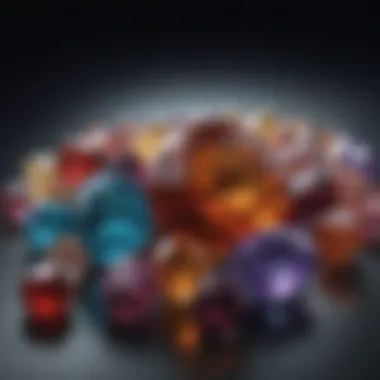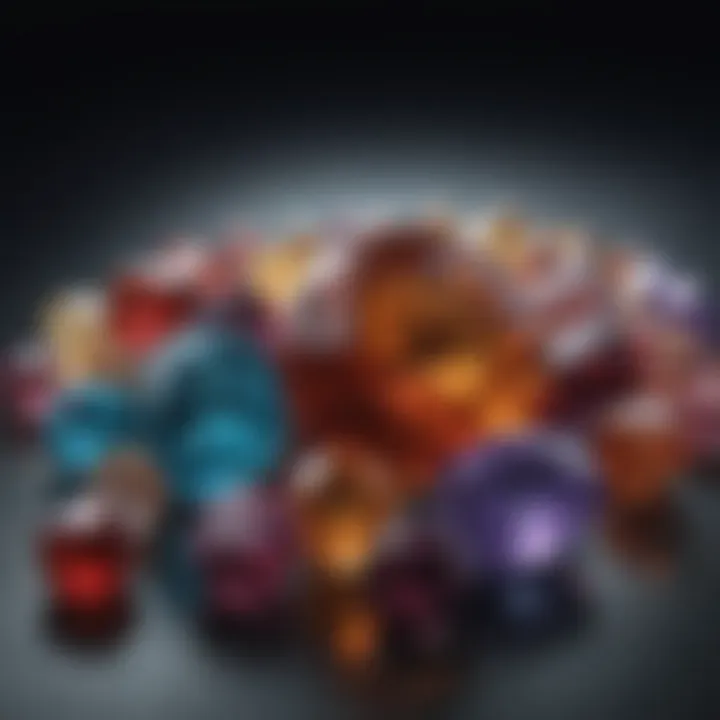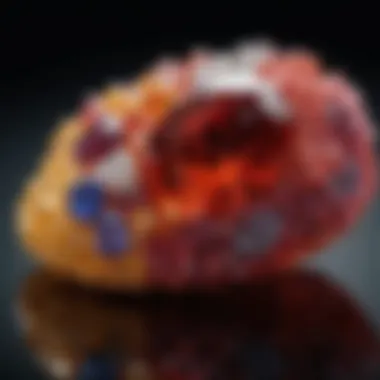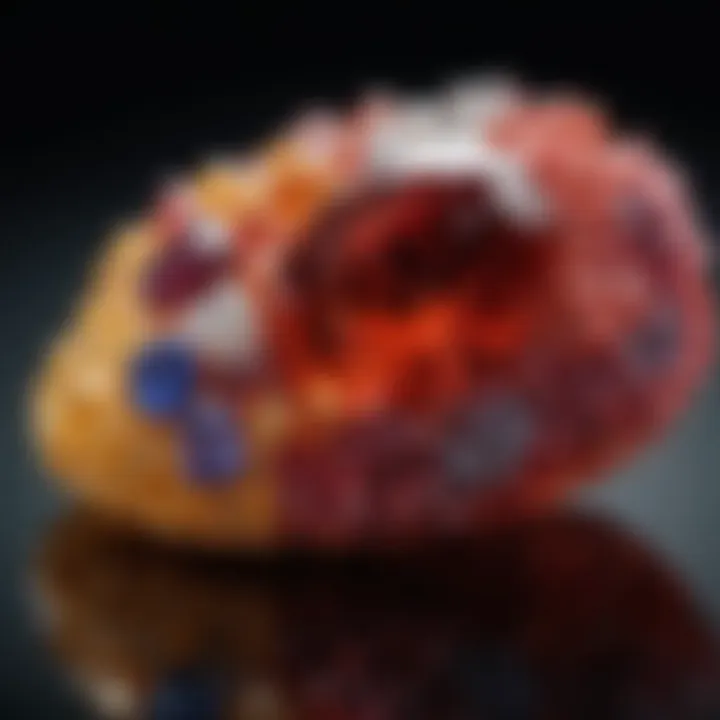The Allure of Uncut Gemstone Jewelry: A Comprehensive Exploration


Intro
Uncut gemstones hold a fascinating charm that goes beyond mere aesthetics. These raw, natural stones possess a uniqueness that appeals not just visually but also culturally and spiritually. They are the untamed treasures of the earth, often considered more authentic than their polished counterparts. While polished stones boast brilliance and clarity, uncut gems tell stories of their origins and journeys through time. By exploring the world of uncut gemstone jewelry, we gain insight into a craft that celebrates the beauty of nature in its most elemental form.
Gemstone Overview
Definition of Gemstones
Gemstones are naturally occurring minerals or organic materials that are cut and polished to produce adornments of beauty. However, uncut gemstones differ. They remain in their original state, showcasing their raw texture and inclusions. This unrefined look often allows for a deeper connection to nature, offering an organic appeal that is increasingly appreciated in modern jewelry design.
Classification of Gemstones
Gemstones can mainly be classified into two categories: precious and semi-precious. While traditionally, diamonds, rubies, sapphires, and emeralds fall under precious, the lines are blurring in contemporary jewelry. Uncut gemstones, irrespective of their classification, are gaining traction amongst designers and consumers alike. Here’s a breakdown:
- Precious Gemstones
Diamonds, sapphires, emeralds, and rubies, known for their superior quality and durability. - Semi-Precious Gemstones
This group includes a wide range, from amethyst to citrine, showing varying degrees of beauty and uniqueness.
Furthermore, uncut stones like rough diamonds or raw garnets have been making waves due to their unusual aesthetic and deeper connection to their origins.
Historical Significance
Origins of Gemstone Use
The allure of gemstones dates back thousands of years. Ancient civilizations, from the Egyptians to the Indus Valley, utilized gemstones for their believed mystical properties and their striking beauty. Jewelry made from uncut stones was often worn not merely as decoration but as a means of protection, with communities attributing different powers to each stone.
Cultural Insights: Gemstones in Ancient Civilizations
In many societies, gemstones served significant roles:
- Egyptians: Used turquoise and lapis lazuli for both adornment and worship, symbolizing divine protection.
- Greeks: Believed that certain stones like amethyst could provide clarity and prevent intoxication.
- Indigenous Cultures: Often viewed gemstones as sacred, using them in rituals and ceremonies to connect with their ancestors.
"Gemstones are not just adornments, they are storytelling stones that encapsulate a timeline of human belief and artistry."
As we take a closer look at the cultural significance of uncut gemstones, we see the remnants of history waiting to be woven into modern design.
The growing appreciation for uncut gemstone jewelry echoes a desire to reconnect with nature, authenticity, and a more sustainable approach to adornment. Central to this trend is the understanding that beauty can exist in its most raw form.
Understanding Uncut Gemstones
Understanding uncut gemstones serves as the foundation for appreciating their unique charm and significance in the realm of jewelry. These stones, in their raw forms, tell their own stories. They speak of ancient origins, geological processes, and the various cultures they have touched. Exploring uncut gemstones also connects us with nature, as these pieces are often sourced straight from the earth, offering a glimpse into beauty unfiltered by human hands.
Defining Uncut Gemstones
Uncut gemstones, often referred to as rough stones, are gems that have not yet undergone the cutting or polishing processes typically associated with traditional jewelry. Unlike their polished counterparts, these stones retain their natural shapes, colors, and effects, making each piece truly one-of-a-kind. A true gem enthusiast can appreciate the allure of their authenticity, something that’s increasingly rare in today’s mass-produced world.
Forms and Varieties
Exploring the various forms and varieties of uncut gemstones adds layers to our understanding, lending insight into what makes them appealing in jewelry design.
Raw Crystals
Raw crystals are perhaps the most iconic representation of uncut gemstones. They come straight from the earth and capture the attention of gemstone lovers for their inherent qualities. Their key characteristic is their natural facets and formations. Unlike polished stones, raw crystals often exhibit external blemishes and imperfections, which many collectors view as badges of honor. This characteristic makes them a popular choice among those seeking authenticity in their jewelry pieces. The unique feature of raw crystals is their diverse colors and formations, which vary enormously, offering a wide range of aesthetic possibilities. However, their always irregular shapes can present a challenge when it comes to crafting jewelry that fits snugly or elegantly.
Natural Shapes
Natural shapes refer to gemstones that, while uncut, possess unique forms shaped by natural processes. The key characteristic of these shapes is their organic appearance, often resembling sculptures from nature itself. They hold an intrinsic charm that speaks volumes about the geological history behind each stone, making them a beneficial choice for artists and designers emphasizing natural aesthetics in their work. The unique feature here lies in their ability to be set in jewelry with little alteration, allowing for quick and organic creation of wearable art. However, their irregularities can limit their versatility in design compared to more standard shapes.
Mineral Compositions
Understanding mineral compositions of uncut gemstones opens a door to their very essence. Each gem is composed of different minerals that contribute to its key characteristic of color, clarity, and hardness. For instance, a piece of uncut sapphire differs vastly from quartz, not only in appearance but also in structure and use. This variety allows designers to choose stones beyond just surface beauty, emphasizing functionality and durability. One major advantage is that through their compositions, you can infer various meanings or purposes associated with each stone, such as healing properties or cultural symbolism. The tricky side is that knowing the exact composition often requires additional expertise or testing, depending on the gem.
"The true beauty of uncut gemstones lies in their imperfections, echoing the very essence of nature itself."
As we explore each type, we note how uncut gemstones embody individuality. Their unique forms inspire creativity, ensuring they remain cherished in both contemporary and traditional jewelry design.
Historical Context of Gemstone Usage
Understanding the historical context of gemstone usage is crucial in appreciating uncut gemstone jewelry. This section sheds light on how humanity's relationship with gemstones has evolved over millennia. Gemstones have not just been objects of beauty; they have held significant cultural, spiritual, and economic value across societies. Knowledge of this context allows enthusiasts and collectors to grasp the significance of uncut gemstones today, beyond their raw beauty.
Ancient Civilizations and Gemstones
Throughout history, ancient civilizations have been deeply intertwined with gemstones. The Egyptians, for instance, used lapis lazuli in their jewelry, believing it to be a symbol of protection and wisdom. In the Indus Valley, carnelian and agate were popular choices for seals, often etched with intricate designs.


Interestingly, gemstones were also believed to hold mystical powers. For instance, the ancient Greeks associated amethyst with tranquility and sobriety, while the Romans thought of emeralds as a sign of fertility and rebirth. These historical perceptions provide a multifaceted perspective on why many cultures today value uncut gemstones; they serve as connectors to both the past and the earth itself.
Symbolism Across Cultures
the significance of gemstones transcends mere decoration. Across cultures, each stone carries specific meanings and symbolism.
Spiritual Meaning
The spiritual meaning behind gemstones is particularly noteworthy. Many cultures hold that these natural stones resonate with different energies, influencing the wearer's spirit. For example, uncut amethyst is often viewed as a calming stone, promoting clarity and peace. This characteristic makes uncut amethyst a favored choice for those seeking inner tranquility. Furthermore, the unique features of its raw form embody authenticity and connection to nature.
Most importantly, the healing qualities attributed to stones like lapis lazuli facilitate emotional release, fostering spiritual growth. Each stone comes alive with the potential for change, marking an enriching journey for the spiritual seeker. This aspect is beneficial because it deepens the connection with the wearer, turning each piece of jewelry into a talisman of sorts.
Royalty and Status
Gemstones have also served as symbols of royalty and status throughout various periods. The glittering allure of uncut diamonds signifies wealth and power. In historical contexts, wearing such stones was often limited to nobility, which added to their mystique. Today, this symbolism remains intact, contributing to the appeal of uncut diamond jewelry among modern elites.
Moreover, the raw, unpolished nature of these gemstones has become a representation of authenticity and individuality, which resonates in contemporary fashion. The unique feature of uncut gemstones lies in each piece’s distinct character, which defies mass production. This represents a calculated rebellion against the uniformity seen in today’s fast fashion.
Gemstones that symbolize status may also invite scrutiny regarding their origins. Questions arise about ethical sourcing, and this presents an enlightening dilemma for modern consumers. Balancing the allure of uncut gemstones with responsible practices fosters a deeper appreciation rooted in both history and contemporary values.
"Gemstones tell tales as old as time. They serve as links to our past, our culture, and our very essence."
In summary, the historical context adds layers to our understanding of uncut gemstone jewelry. From ancient civilizations that revered their spiritual significance to the royal adornments that signaled power, each stone carries rich narratives worth exploring. By recognising these connections, collectors and enthusiasts can make informed choices that honor both the gemstones themselves and the traditions they embody.
Craftsmanship in Uncut Jewelry
Craftsmanship plays a fundamental role in the world of uncut gemstone jewelry. It’s not just about putting stones into settings; it’s about creating art that connects customers to the raw beauty of nature. Every piece tells a story, showcasing not only the uniqueness of the gem but also the skill of the artisan behind it. Understanding this craftsmanship provides a deeper appreciation for these exquisite pieces.
Techniques in Mounting
Soldering and Setting
Soldering and setting are essential techniques in the mounting of uncut gemstones. This process involves using heat to join metal parts together, which provides a secure base for the stone. The durability of this method is a key characteristic, as it ensures that the gemstone is held securely within its mount. For artisans and jewelry designers, soldering enables the creation of intricate designs that incorporate various metals, enhancing the overall aesthetic appeal of the jewelry.
A significant advantage of soldering is that it allows for a seamless finish—jewelry not only looks good but is also sturdy enough for daily wear. However, it’s essential to be mindful that improper soldering can lead to weak points that may eventually cause the gemstone to dislodge. This makes expertise in soldering critical for artisans aiming to craft lasting creations.
Creating Unique Designs
Creating unique designs is what truly sets uncut gemstone jewelry apart in today’s market. Unlike traditional gemstones that are often cut and polished, uncut stones retain their natural forms, which allows artisans to incorporate organic shapes into their creations. This particularity is a hallmark of their appeal as it showcases individuality and the inherent beauty found within raw materials.
Artisans enjoy the freedom to experiment with forms and placements, which often leads to breathtaking configurations not seen in mass-produced pieces. Custom designs can evoke personal connections, reflecting the wearer's style while highlighting the unprocessed nature of the gemstones. The only drawback is that this approach can lead to higher costs and may take significantly more time compared to more standard practices in mass production.
Artisan vs. Mass Production
When considering craftsmanship in uncut gemstone jewelry, the contrast between artisan and mass production becomes evident. Artisan jewelry is crafted with a careful attention to detail, often resulting in one-of-a-kind pieces that resonate with the wearer's personal story. Artisans take the time to understand the characteristics of each stone they work with, ensuring that the settings and overall designs complement the gems’ natural allure.
On the flip side, mass production offers consistency and affordability, which can appeal to a broader audience. Techniques used in mass production often prioritize efficiency, which may sacrifice the unique touch that artisan-crafted pieces provide. However, for many gemstone enthusiasts, the focus on individuality and craftsmanship is paramount, making artisan jewelry a worthwhile investment that reflects not only personal style but also values the skill of the creator.
"In a world filled with mass production, uncut gemstone jewelry stands as a testament to the artistry and craftsmanship that breathes life into each piece."
Through careful craftsmanship, techniques like soldering and unique design outcomes deliver a compelling narrative around uncut gemstones. This deeper understanding opens up pathways for consumers to recognize the dedication, skill, and artistic vision behind what they wear—pieces are not just accessories; they are conversation starters rooted in history and skilled artistry.
The Aesthetic Appeal of Uncut Gemstones
The aesthetic appeal of uncut gemstones lies deeply rooted in their natural characteristics and organic forms. Uncut gemstones embody a certain rawness that is becoming increasingly sought after in the world of jewelry. They carry a visual and tactile beauty that polished stones simply cannot replicate. This makes them a captivating choice for those wanting to display nature’s handiwork in its truest form.
Natural Beauty
Imperfections and Character
The charm of imperfections is one of the defining traits of uncut gemstones. Unlike their polished counterparts, these stones present a genuine narrative etched in their very structure. Each flaw, each minute fissure tells tales of their formation, presenting a mosaic of experiences that polished stones lack. This authenticity resonates with many jewelry enthusiasts who appreciate authenticity over uniformity. It is these very imperfections that render each piece unique, much like fingerprints.
Moreover, the organic character of these stones means they stand out in a crowded market of identical, mass-produced pieces. For many, wearing something that is imperfect but full of character is an expression of individuality. However, while the unique visuals can be enchanting, potential buyers might also need to consider practicality—certain imperfections may make the stone more fragile.
Color Variations
Color variations in uncut gemstones are akin to a painter's palette—vivid, unexpected, and varied. Each stone can possess a spectrum of hues depending on its mineral composition, lending itself to versatile design opportunities. For example, an amethyst might present in deep purples, but within the same rough stone, lighter lavender shades may also emerge.
Such variations invite creativity; jewelry designers can play with these color contrasts to enhance the overall aesthetics of their works. The unique feature here is the ability of these colors to shift under different lighting, providing a dynamic appearance that keeps the eye captivated. However, the very thing that makes these stones beautiful also poses challenges. Certain color varieties may be rare or difficult to source, which can affect the final value of the piece.
Influence on Contemporary Jewelry Trends


Uncut gemstones are making waves in contemporary jewelry trends as people become more conscious of sustainability and individual expression. The rise of a 'slow fashion' movement has prompted consumers to search for unique pieces that tell a story.
In this light, jewelry featuring uncut stones becomes more than just an accessory. It's a statement reflecting the owner’s values—values centered on nature, authenticity, and a breakaway from mass-market trends. Such pieces can often be found in artisan shops, showcasing the deep bond between artist and medium.
This shift toward the use of uncut gems has also influenced major fashion runways and curated collections, driving both industry and consumer interests toward natural forms. As sustainability becomes more than just a buzzword, trends will likely continue to evolve around natural and ethical sourcing, solidifying the uncut gemstone's place in the market.
"The raw and the beautifully imperfect are the gems of the future, where authenticity reigns supreme in design and aesthetics."
Metaphysical Properties of Uncut Gemstones
The metaphysical properties of uncut gemstones capture the fascination of many enthusiasts and collectors. They are often viewed not just as physical adornments but as potential vessels for energy and healing. These raw treasures of the earth hold ancient wisdom; people have believed in their power for centuries. The allure lies in their perceived ability to influence emotional and spiritual dimensions of life, making them attractive choices for both personal use and gifts.
Healing Qualities
Energy Transfer
One prominent aspect of uncut gemstones is their energy transfer. Each gemstone is thought to carry its own unique vibrational frequency. When worn or held, they have the potential to interact with the wearer’s energy field, transferring their positive attributes. This contributes greatly to the appeal of uncut gemstones within holistic practices. For instance, it's believed that wearing a raw amethyst can enhance clarity and tranquility in turbulent times.
This method of energy transferral stands out as a central characteristic of these gemstones, providing not just aesthetic beauty but emotional and therapeutic benefits. A unique feature lies in their natural, unrefined state—many enthusiasts argue that the energy is more potent when the gemstones remain uncut and untouched. However, the effectiveness of energy transfer may depend on personal beliefs and experiences, which leads to an interesting spectrum of acceptance within different communities.
Chakra Alignment
Another key element within the realm of metaphysical properties is chakra alignment. This concept revolves around the belief that certain gemstones can influence the body’s energy centers or chakras. Utilizing gemstones for this purpose is said to help balance and harmonize one's spiritual and physical well-being. For example, turquoise is frequently associated with the throat chakra, believed to promote effective communication and self-expression.
The fundamental characteristic of chakra alignment is its focus on maintaining a flow of energy that contributes to health and vitality. Unique to this practice is how raw gemstones can resonate with specific chakra frequencies, often leading to profound personal experiences. However, some may find that relying solely on gemstones for chakra work may not provide immediate results and should complement other wellness practices, like meditation and yoga.
Spiritual Significance
The spiritual significance of uncut gemstones extends beyond their healing qualities; they represent a bridge between the physical realm and the metaphysical world. Within various cultures, specific gemstones have been imbued with spiritual meanings, believed to connect individuals to higher consciousness or divine energy. For many, wearing uncut gemstone jewelry can serve as a reminder of their spiritual journey, echoing the essence of their unique life path.
Gemstones like quartz and citrine, for example, are often celebrated for their perceived ability to enhance intuition and manifest intentions. While scientific validation of these beliefs remains limited, the personal stories from wearers often provide a rich tapestry of experiences that add depth to their spiritual significance. As each gemstone tells a story, individuals are motivated to select stones that resonate personally, enhancing their spiritual journey.
"Uncut gemstones are not just jewelry; they are a reflection of one's journey, both internal and external."
Caring for Uncut Gemstone Jewelry
Caring for uncut gemstone jewelry is not just about maintaining its physical appearance; it's a matter of preserving its essence. The raw, unpolished charm of these gems can easily wear down or lose their luster if not treated with respect and diligence. Therefore, understanding the proper ways to care for these pieces is invaluable for anyone who cherishes the beauty of nature in wearable art.
Avoiding Damage
Cleaning Techniques
Keeping uncut gemstones pristine means employing the right cleaning techniques. Unlike their polished counterparts, these stones can be more sensitive to certain chemicals or physical stress. A gentle approach is all that’s needed.
- Opt for Mild Solutions: Using a soap and water solution is often recommended. Distilled water helps, as it is free from contaminants that might mar the stone's surface.
- Soft Cloths: Always clean your jewelry with a soft cloth to avoid scratches. Some folks swear by using microfiber cloths since they can lift dirt and oil without damaging the stones.
The key characteristic of these cleaning methods is their gentle nature. For example, a harsh cleaner could strip the natural oils that add life to the gemstone, resulting in a dull appearance. On the flip side, some may argue that conventional cleaning solutions are faster but in reality, they may do more harm than good.
Storage Guidelines
When it comes to protecting uncut gemstones, careful storage is just as crucial. Storing jewelry with care can significantly extend its life.
- Individual Pouches: Each piece should be kept in its own soft pouch or box. This minimizes the risk of scratches from hard surfaces or other gems.
- Avoid Humidity: Stash them in a cool, dry place, away from sunlight—excessive moisture can lead to undesired changes in color.
The beauty of these storage practices lies in their simplicity. Individual pouches safeguard against the clinking and scratching that can occur when pieces are tossed together. However, remember that poorly made pouches may not offer the protection you desire.
Periodic Inspections
Periodic inspections serve as a friendly reminder to check the integrity of your favorite pieces. Taking the time to look for cracks or loose settings can prevent more significant issues down the line. It's insightful to maintain an inspection routine, staying attentive to every nook and cranny. Inspecting gems doesn’t just preserve their beauty; it can also reveal underlying issues that might require fixing.
Focusing on these care practices ensures that your uncut gemstone jewelry remains as magnificent as the day you first wore it. With proper care, your collection can tell stories for years to come.
Market Trends in Uncut Gemstone Jewelry
The world of uncut gemstone jewelry is not just a niche but a thriving market that reflects our changing tastes and values. As the fashion landscape evolves, so do the preferences of buyers who are increasingly seeking unique pieces that tell a story. This section will delve into the nuances of these trends, helping you understand why uncut gemstones have captured the attention of jewelry enthusiasts around the globe.
Growing Popularity
In recent years, there’s been a noticeable surge in the popularity of uncut gemstones. Many consumers opt for raw gemstones not just for their aesthetics but also for the narrative behind them. Each piece can be seen as a miniature work of art, bearing unique marks that tell of its origin and the geological journey it has undergone. This preference aligns with a broader trend toward individuality and sustainability within consumer choices.
Opinions on fashion have shifted as well. Customers today lean towards designs that boast an organic feel rather than the polished perfection of traditional gemstones. This embrace of imperfection is a declaration of authenticity that resonates with an audience seeking to forge deeper connections with their possessions. Additionally, the rise of social media platforms has provided a stage for uncut gemstone jewelry to shine, with influencers and designers showcasing their creations to a wide audience, further solidifying its desirability.


Investment Potential
Whether for passion or profit, uncut gemstone jewelry is being viewed as an increasingly viable investment avenue. Investors and collectors alike are realizing the potential returns that thoughtfully chosen uncut stones can yield. However, understanding this investment landscape requires a discerning eye.
Evaluating Value
When it comes to determining the value of an uncut gemstone, several factors come into play.
- Rarity: Unique stones with uncommon origins or compositions naturally fetch a higher price. For instance, a piece sourced from a lesser-known region might be valued more than one that's mass-produced simply due to its scarcity.
- Condition: Unlike cut gemstones, the condition of an uncut stone can significantly affect its price. Stones that have maintained their integrity while showcasing striking features can be more appealing to both collectors and jewelry makers.
This aspect of evaluating value is crucial because it directly influences future resale opportunities. Being savvy in assessing these qualities means one can make informed choices, ensuring that their investment appreciates over time.
Market Demand Factors
Understanding the factors that drive market demand is essential for both enthusiasts and investors. On one hand, there’s a growing awareness and appreciation for natural, sustainable products, which feeds into the demand for uncut gemstones. On the other hand, trends in the jewelry industry shift as styles change, incorporating more raw elements into mainstream designs.
- Cultural Shift: There's a growing cultural movement toward sustainable and ethical practices, encouraging potential buyers to seek out products that align with their values. This trend fosters a demand for uncut gemstones as they are often more sustainably sourced than traditional cuts.
- Celebrity Influence: The impact of celebrities endorsing or wearing unique uncut pieces can lead to dramatic spikes in desirability and, consequently, price.
This interplay of market forces points to a promising future for uncut gemstones, with their ability to offer both personal satisfaction and potential financial returns.
"Investing in uncut gemstones isn’t just about profit; it’s also about embracing the stories each piece has to tell."
All in all, the trends in uncut gemstone jewelry showcase a shift toward individuality, sustainability, and investment savvy—a trifecta that is likely to shape the future of this unique niche.
Cultural Impact of Gemstone Jewelry
The fascination with uncut gemstone jewelry transcends mere aesthetics, weaving through the fabric of culture across generations. Jewelry is often not just an accessory; it embodies stories, emotions, and beliefs that can be traced back through time. Understanding the cultural impact of gemstone jewelry illuminates its importance, revealing how these raw stones connect us to our past, influence our present, and may even shape our future.
Cultural Significance
Gemstones in Rituals
Gemstones have held a vital role in various rituals throughout history. In many cultures, these stones are believed to possess not only physical beauty but also spiritual properties. For instance, during weddings or significant life events, the inclusion of gemstones can symbolize strength, protection, and blessings. Gemstone choices often vary, as some cultures attribute specific meanings to particular stones. Take the red coral, often incorporated in traditional Indian wedding attire; it is seen as a symbol of life and prosperity.
The unique feature of gemstones in rituals is their duality of being both ornamental and symbolic. Wearing uncut formations during ceremonies can invoke an intimate connection to one’s heritage, making it a thoughtful choice for individuals seeking more than just a decorative piece.
However, the use of gemstones isn't without its pitfalls. In some regions, plentiful superficial beliefs can cloud genuine cultural significance, running the risk of reducing rich traditions to mere trends. In our exploration, it’s crucial to discern genuine value versus fleeting fads that might overshadow the precious history behind these stones.
Traditional Jewelry Practices
Traditional jewelry practices also contribute immensely to the cultural landscape. For many communities, adorning oneself with gemstones reflects not just personal style but also cultural identity. For example, the Navajo people carry a profound connection with turquoise. This deeply rooted practice highlights how gemstones are interwoven with tribal identity and historical narratives.
The choir of colors and forms in traditional designs speaks volumes about craftsmanship and lineage. By choosing to wear and promote such pieces, enthusiasts support artisans who preserve these age-old techniques. This makes traditional practices both a beneficial choice for the article and a respectful tribute to the craft.
Yet, preserving these practices requires a balance; with world markets pushing for mass-produced jewelry, the risk of losing authentic artistry looms. True appreciation of uncut gemstone jewelry often hinges on understanding and valuing the narratives behind traditional practices, urging collectors to tread thoughtfully in their acquisition of cultural pieces.
Modern Interpretations
As we move forward, interpretations of gemstones evolve, reflecting contemporary values and style preferences. The rise of minimalism in design fosters a new appreciation for the raw, unpolished allure that uncut gemstones present. Instead of hiding behind lavish settings, these stones stand proud, almost daring the wearer to embrace their natural beauty.
In modern contexts, gemstone choices frequently highlight personal stories or aspirations. Using uncut stones, designers can craft unique jewelry that resonates on a deeper level. A piece featuring raw aquamarine, for instance, may not only appeal for its stunning hues but also for its reputed calming effects, making it a meaningful talisman in today's fast-paced life.
By bridging ancient cultural practices with modern interpretations, we witness a thrilling dialogue that continues to shape the narrative around uncut gemstones. In a world rich with options, understanding the essence behind the stones creates a deeper connection, urging wearers to celebrate their individuality while recognizing the artful journey that brought these gems from earth to adornment.
The Future of Uncut Gemstone Jewelry
In the ever-evolving realm of jewelry design, uncut gemstones are carving out a niche that pays homage to their natural charm and raw beauty. Looking ahead, the significance of uncut gemstones is not just a passing trend but a reflection of broader changes in consumer values and artistic expressions. The blend of innovation and sustainability might well define the next chapter of uncut gemstone jewelry, influencing how it is perceived and crafted.
Innovation in Design
As jewelry designers are increasingly pushing the envelope, innovation in the design of uncut gemstone jewelry is becoming more pronounced. Rather than simply focusing on traditional mounts, designers are incorporating contemporary artistic methods, which can include geometric patterns or asymmetrical arrangements. This move away from convention allows designers to showcase the unique characteristics of each stone, celebrating their imperfections rather than hiding them.
Customers are gravitating towards pieces that tell a story, encapsulating personality and emotion. For instance, a striking uncut diamond might be set in a sleeve of silver spirals, suggesting a natural flow that mimics the stone's own organic growth. These innovations not only provide a fresh outlook on uncut gems but also invite discussions on the relationship between nature and human creativity.
Sustainability Practices
Ethical Sourcing
An emerging focus on ethical sourcing is crucial in the future landscape of uncut gemstone jewelry. As consumers become more aware of environmental and social impacts, they seek out gemstones that are mined with respect for the land and its communities. Ethical sourcing emphasizes transparency in the supply chain, which builds trust between jewelers and customers. This is a unique characteristic that sets ethical practices apart in a fragmented industry.
The beneficial choice of ethical sourcing serves to not only protect ecosystems but also support local economies, by ensuring fair wages and working conditions for miners. A significant advantage of this approach is that it cultivates a sense of connection; wearing an ethical gemstone infuses the jewelry with meaning while reducing one's carbon footprint on the Earth.
Environmental Considerations
Environmental considerations also play a pivotal role in shaping the future of uncut gemstone jewelry. With a growing emphasis on sustainability, jewelers are increasingly adapting techniques that minimize waste and reduce environmental impact. This might involve practices like responsible mining which conserves ecosystems and prohibits the use of harmful chemicals.
Furthermore, environmentally considerate practices encourage a circular economy, where old jewelry can be repurposed instead of discarded. This unique feature not only preserves resources but also aligns with the rising consumer demand for environmentally friendly products. The challenge, however, lies in balancing these sustainable practices with the cost of production, which can sometimes result in higher prices for the consumer.



